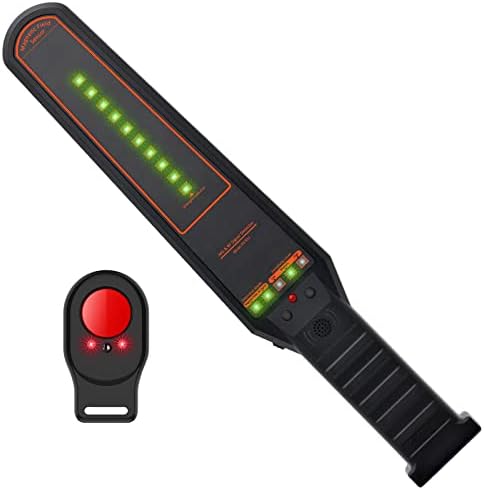Unmasking the Invisible: Using Anti-Spy Detectors in Counter-Surveillance Training
In today’s increasingly interconnected world, the risk of surveillance is higher than ever. Whether you’re a high-profile individual, a journalist investigating sensitive matters, or simply someone concerned about privacy, understanding counter-surveillance techniques is crucial. A key component of effective counter-surveillance is the use of anti-spy detectors, and incorporating them into comprehensive training programs is essential for developing robust protective measures. This article explores the role of anti-spy detectors in counter-surveillance training, offering practical insights and advice.
Why Counter-Surveillance Training Matters

The threat of surveillance isn’t limited to governments or large corporations. Sophisticated surveillance technology is readily available, allowing individuals and groups to monitor activities discreetly. This can range from simple camera surveillance to more advanced techniques employing bugs, GPS trackers, and even sophisticated software to intercept communications. Counter-surveillance training empowers individuals and organizations to identify these threats and mitigate their risks.
The Role of Anti-Spy Detectors in Training

Anti-spy detectors are specialized devices designed to detect a wide range of surveillance equipment. They are invaluable tools in counter-surveillance training because they provide hands-on experience in identifying hidden threats. Effective training programs should incorporate a variety of detectors, enabling trainees to understand their capabilities and limitations.
Types of Anti-Spy Detectors Used in Training
Several types of anti-spy detectors are commonly used in counter-surveillance training, each designed to detect specific types of surveillance equipment:
- Bug Detectors: These devices detect radio frequency (RF) emissions from hidden microphones and listening devices. Different models have varying sensitivities and frequency ranges, allowing detection of both analog and digital bugs.
- GPS Tracking Detectors: These detectors identify GPS signals emitted by tracking devices, helping pinpoint their location and facilitating their removal.
- Camera Detectors: These detectors identify the infrared (IR) emissions from hidden cameras, revealing their presence even in low-light conditions. They can detect both wired and wireless cameras.
- Sweepers/Signal Detectors: These devices detect a broad spectrum of RF signals, including those from bugs, cameras, and other surveillance technologies. They’re useful for quickly scanning an area for potential threats.
- RF Jammers (for advanced training): While not strictly detectors, RF jammers disrupt RF signals and are sometimes included in advanced counter-surveillance training. Their use, however, is often subject to legal restrictions and should be conducted only under controlled circumstances and with expert guidance.
Practical Application in Counter-Surveillance Training

Effective counter-surveillance training goes beyond simply showing trainees how to use detectors. It involves practical exercises in real-world scenarios. For example:
- Simulated Environments: Trainees can practice identifying hidden devices in specially designed rooms equipped with various types of surveillance equipment.
- Sweep Procedures: Trainees learn systematic procedures for thoroughly sweeping a room or vehicle for bugs and other hidden devices.
- Threat Assessment: Training should also focus on evaluating the overall risk of surveillance, identifying potential vulnerabilities, and developing appropriate mitigation strategies.
- Response Strategies: Once a threat is detected, trainees must learn how to respond effectively, which could involve removing the device, alerting authorities, or modifying behavior to reduce exposure.
Choosing the Right Anti-Spy Detector for Training
The choice of detectors for training depends on the specific needs and objectives. Some factors to consider include:
- Sensitivity and Range: More sensitive detectors can detect weaker signals, but they may also be more susceptible to false positives. Range determines how far away a device can be detected.
- Frequency Range: The wider the frequency range, the more types of devices can be detected.
- Ease of Use: Detectors should be user-friendly and easy to interpret, particularly for beginners.
- Portability: For fieldwork simulations, portability is crucial.
Beyond the Technology: Developing a Holistic Approach

While technology plays a vital role, effective counter-surveillance relies on more than just gadgets. A comprehensive training program should also encompass:
- Operational Security (OPSEC) Principles: Understanding how to minimize your digital and physical footprint is essential.
- Communication Security: Learning to protect your communications from interception through encryption and secure channels is vital.
- Physical Security Awareness: Understanding how to secure physical spaces and protect against unauthorized access.
Conclusion:
In conclusion, anti-spy detectors are indispensable tools in counter-surveillance training. By combining practical hands-on experience with a comprehensive understanding of OPSEC principles, individuals and organizations can significantly enhance their ability to protect themselves from unwanted surveillance. Investing in thorough counter-surveillance training, incorporating a variety of anti-spy detection techniques, is a crucial step in safeguarding privacy and security in today’s technologically advanced world.